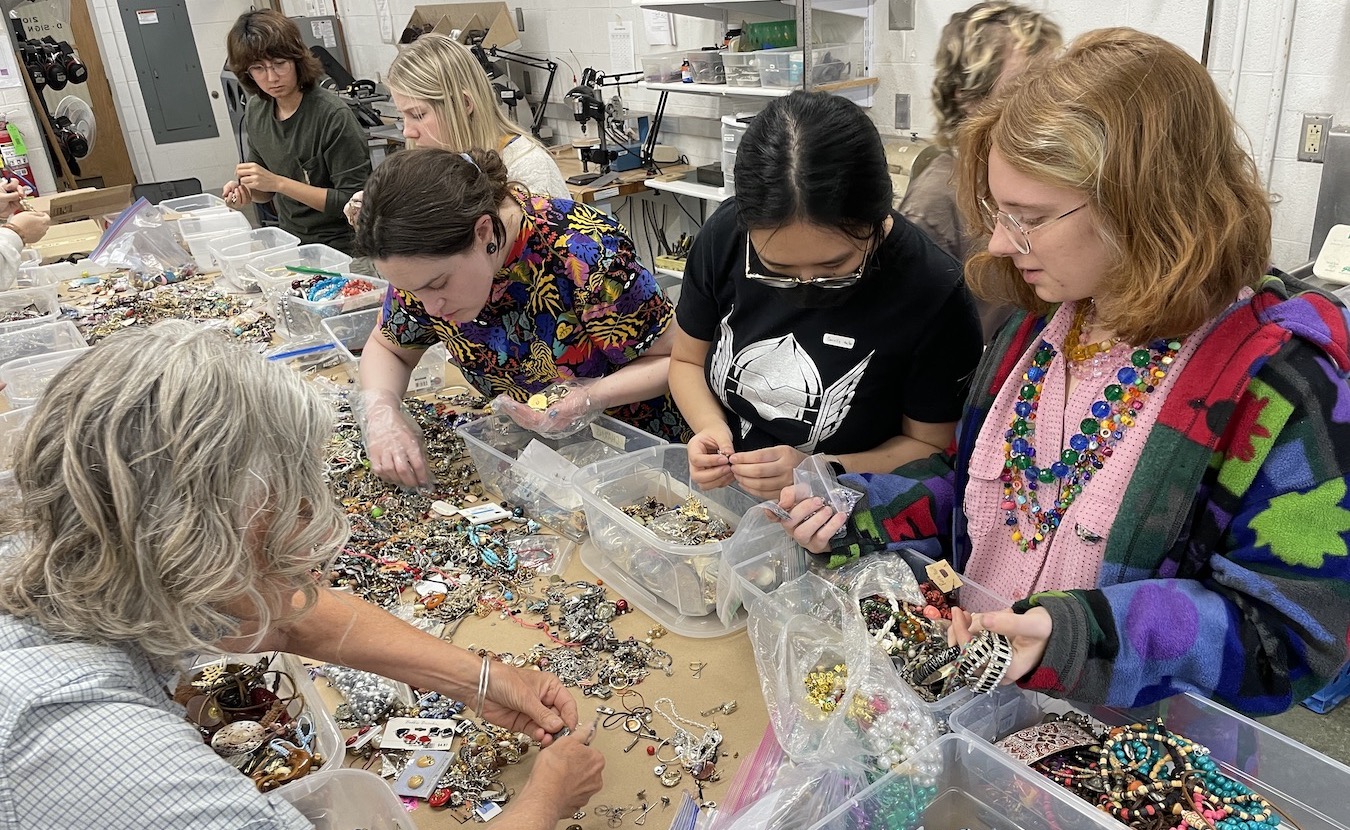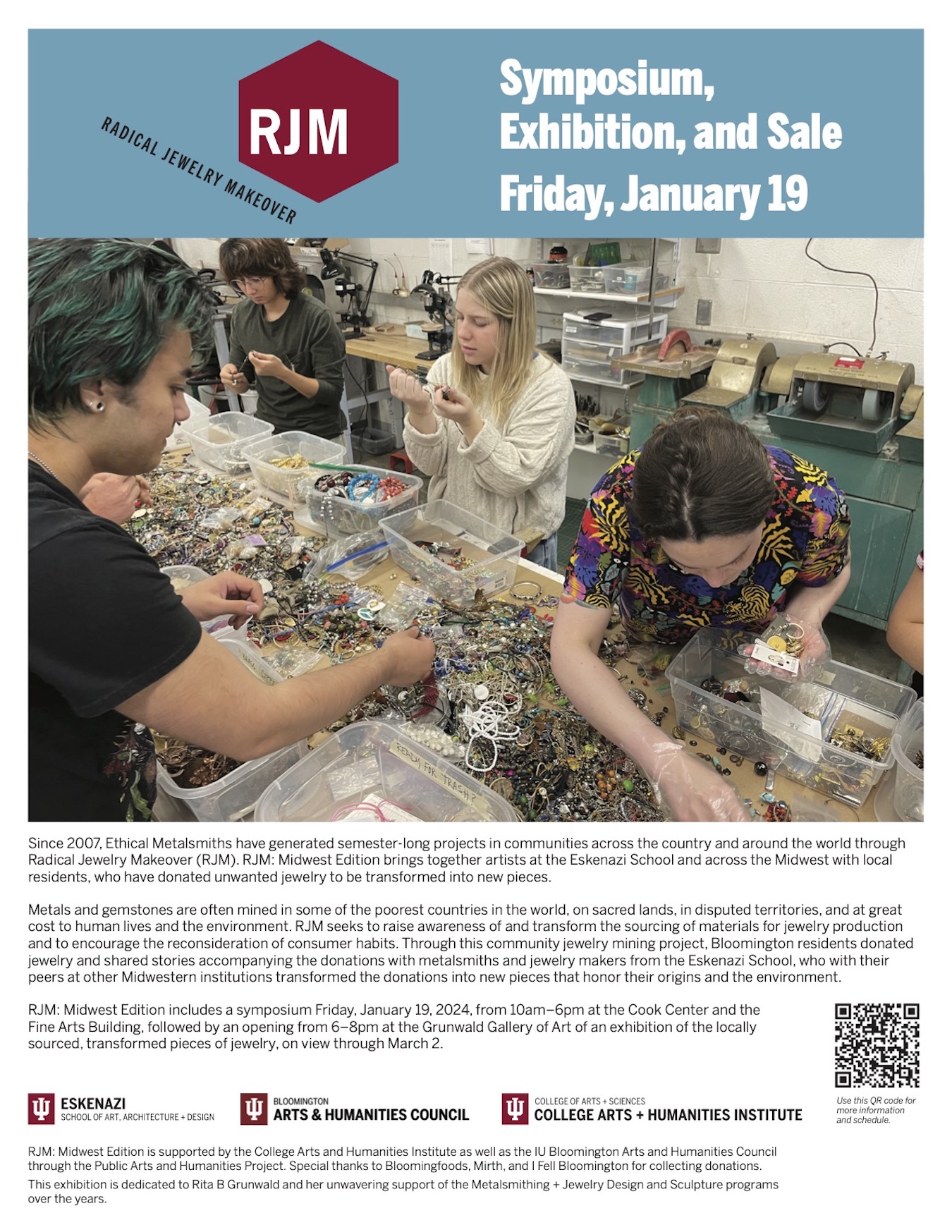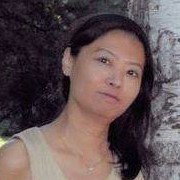Jewelry is becoming radical in Bloomington. Indiana University Professor Nicole Jacquard and Visiting Assistant Professor Angela Caldwell lead the collaboration between the IU Eskenazi School of Art, Architecture + Design and the artist-run nonprofit Ethical Metalsmiths, to recreate jewelry pieces from donated items to be showcased in an upcoming Radical Jewelry Makeover (RJM) exhibition.
RJM items will be produced by metalsmithing and jewelry design students from IU, Ball State University, Bowling Green University, Earlham College, and Western Michigan University, and by professional jewelers from Gallery 2052 in Chicago. RJM pieces will be produced by December 13, after which each school will jury the pieces produced by their own students to select the best ones for exhibition at the Grunwald Gallery of Art in January 2024.
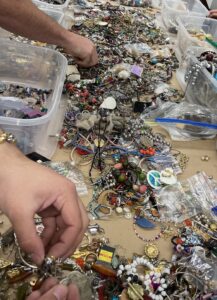
Metalsmiths and jewelry makers will turn these and other donated pieces into new jewelry that will be juried and shown in an exhibition at the IU Grunwald Gallery of Art in January as part of Radical Jewelry Makeover Bloomington. | Courtesy photo
Since 2007, RJM has generated semester-long projects in communities across the country and around the world. RJM Bloomington, in particular, encourages the reconsideration of consumer habits and the sourcing of materials for jewelry production through its focus on the creativity and skills of local jewelry designers, and by promoting the individual stories that accompany RJM donations.
Metals and gemstones for jewelry production are often mined in the world’s poorest countries, on lands considered sacred, and in disputed territories. The extraction process for these materials has also negatively impacted the environment and put human lives at risk. For example, the U.S. Government Accountability Office specifies the hazards of mining hardrock minerals like gold, silver, and copper. Moreover, although the Minamata Convention on Mercury was ratified ten years ago, mercury continues to be used to separate gold from mud, a practice that is harmful to miners and the environment.
To manage the harms of mining, Ethical Metalsmiths (EM), a nonprofit based in Cincinnati, Ohio, encourages the use of ethically sourced materials for jewelry production. EM educates the public about responsible mining, while promoting transparency in jewelry supply chains and promoting the collective efforts of jewelers who attempt to modify their own practices. EM envisions a world where responsibly sourced jewelry can be produced and enjoyed. Such ethical sources for jewelry production would protect and sustain the earth, its people, and cultures.
Full circle metalsmith
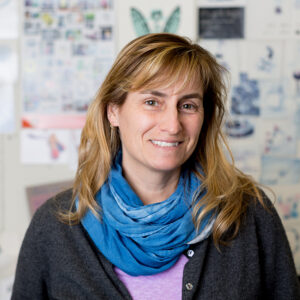
Nicole Jacquard, Indiana University professor and area head of metalsmithing and jewelry design at the IU Eskenazi School of Art, Architecture + Design. | Courtesy photo
Nicole Jacquard, professor of metalsmithing and jewelry design, has always been interested in art. Her father, Jerald W. Jacquard, who served as head of sculpture at IU for over 30 years, had produced the monumental sculpture works that were her childhood jungle gyms before they were installed in Bloomington and housed in collections across the U.S. She says, “Art was all around me and I was drawn to making things with my hands for as long as I can remember. I could express myself by physically showing you what I was thinking.”
Jacquard’s interest in metalsmithing and jewelry design was inspired by her older sister, who brought home in-progress projects from her high school classes. She says, “I was fascinated by the things she brought home to work on — from paper models which were then translated into metal.”
After earning a bachelor’s degree from IU in 1991, Jacquard received her first Master of Fine Arts degree from the University of Michigan in 1994. During her Fulbright Fellowship that began in 1995, she earned her second M.F.A. from the Royal Melbourne Institute of Technology University in Australia. In 2001, she returned to RMIT, where she earned a Ph.D. in fine arts. She says, “For the next four years, I was studying and teaching in their gold and silversmithing program and loving it.”
Jacquard eventually accepted a tenure-track faculty position in the metalsmithing and jewelry design area at IU. “It is hard to believe that I have come full circle, and I am now the head of the metals program at IU,” she says.
The Sorting
Jacquard first heard about Radical Jewelry Makeover from colleagues who had hosted their own RJM programs. Following the popularity of the RJM event that visiting artist Susie Ganch had hosted for the metals area at IU in spring 2022, Jacquard decided to expand the reach of RJM. She says, “I was excited to share the experience with a larger group of people to have an even bigger impact on our students and the field in general.”
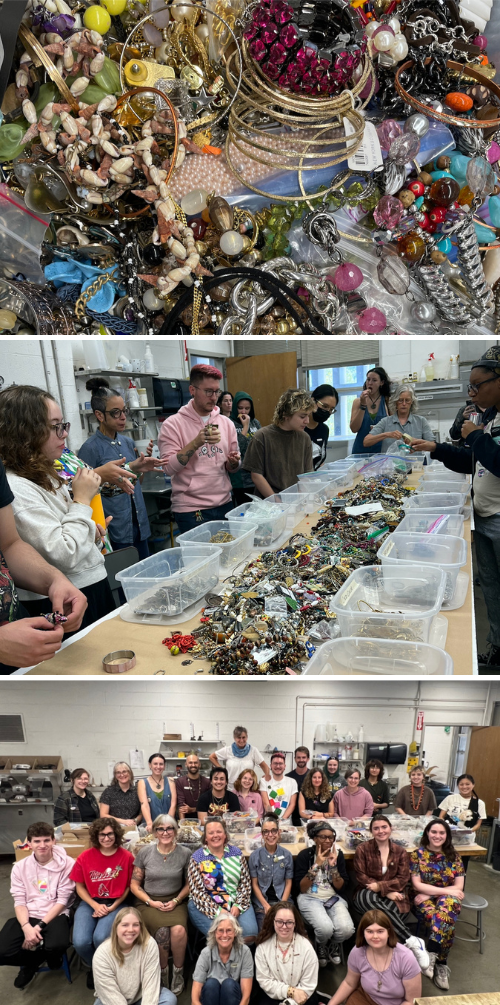
(top to bottom) The assortment, the sorting, the sorters. | Courtesy photos
The most rewarding aspect of the RJM project has been the community’s willingness to donate jewelry, Jacquard says. There were 166 donations through IU alone, some of which she calls “extremely generous.” Through other participating schools and colleagues from Chicago, over 250 donations were received. She says, “Group projects like this are exciting and a great opportunity for faculty, students, and professionals to get together and share their expertise, knowledge, and experience.”
For Jacquard, the most challenging aspects of RJM are fundraising for the pre-exhibition symposium and the logistics of curating over 200 pieces of work as merchandise that will benefit Ethical Metalsmiths. However, students will facilitate curation through volunteer work. She says, “Our students will also be instrumental in hanging the show, which is a wonderful hands-on teaching experience for them and a component of professional practice in our area.”
When asked if there was anything particular about the RJM project that she would like to share, she mentioned the event’s kickoff, “The Sorting,” that took place September 15–16. This aspect of the project involved categorizing all donations after estimating the value of each one. Forty categories emerged during this “sorting” process. These included gold, silver, copper, brass, natural stones, natural materials, plastic beads, holiday-themed pieces, gold-colored chain, flora and fauna, and rhinestones. During the process, precious metal pieces were separated from costume jewelry, and from those made of pot metal, a material manufactured for fast, inexpensive castings.
According to Jacquard, although there were some significant donations, like the one from Joan Goodman, former owner of Goodman Jewelers in Bloomington, most of them ended up being categorized as “costume jewelry.” Even so, because most individual donations were broken items, single earrings, and outdated pieces that include gold or silver, the total number of donations received could be deemed significant for a single RJM drive. Thus, approximate weight and value were determined for the donated silver and gold. The donated value was estimated at nearly $38,000 in today’s market. Jacquard says, “We were honestly overwhelmed and it was truly amazing to realize just what people collectively gave us.”
The silver and gold were divided between RJM project participants to be used “as is” or to be melted down and poured into ingots that could be converted into wire, sheet, and other forms. Participants also selected pieces from the 40 bins of costume jewelry to recreate items. While most of these RJM creations will be donated to Ethical Metalsmiths, some will be sold at the RJM exhibition.
Jacquard hopes to achieve through RJM Bloomington “a sense of place” and “a community of giving” where people respond and take action. She says, “I want our students to know where their materials come from as well as the cost to the environment — not only through mining practices, but also through the waste of fast fashion and our throw-away economy. In order to be good stewards for this area, community, country, and planet, we need to change and adapt better practices in order to disrupt and hopefully eliminate a lot of the destructive toxic cycle of waste. This is just a step.”
Gold rings forever connected
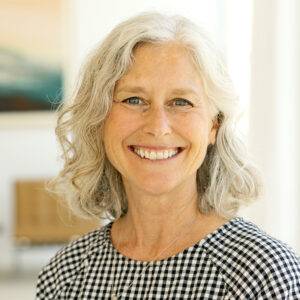
Angela Caldwell, IU visiting assistant professor of metalsmithing and jewelry design at the IU Eskenazi School of Art, Architecture + Design. | Courtesy photo
A visiting assistant professor of metalsmithing and jewelry design, Angela Caldwell has always been intrigued by jewelry. “I was allowed to play in my Grandma’s jewelry box as a child and loved the variety of materials, findings, and settings,” she says. She values the RJM project because it combines three of her “favorite things”: vintage items, or memories of visits to her grandparent’s house; the reusing, or repurposing, of objects; and jewelry design and production. She says, “I love the field of jewelry as it feels precious in the sense that someone is choosing to place an object on their body and it can tell such a story and create lasting memories.”
RJM Bloomington donations can be transformed to create new pieces in various ways. Caldwell says that reset stones or other settings for brooches have been taken apart. Machine-made chains have been combined with donated objects, and precious metal has been melted down and refined into sheet or wire. Caldwell recommends checking out RJM on Instagram, saying, “There are great examples.”
For Caldwell, the most rewarding aspect of contributing to the RJM project has been reading the stories shared with each donation. She says, “We’ve received an overwhelming amount of jewelry — which is a great challenge to have — and reading why someone chose to donate family collections has been very touching.”
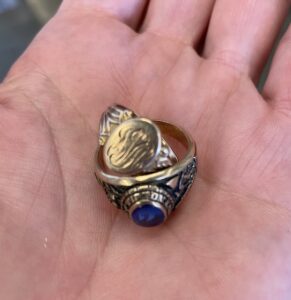
Jacquard will combine these two gold rings at the request of the donor, whose class ring will be “forever connected” to her grandfather’s pinky ring. | Courtesy photo
For example, one donation came with a story about two gold rings:
“The rings are my class ring … and my grandfather’s pinky ring. He lived far away during my childhood and died relatively young, and I never really knew him. It would be nice if both rings could be used in the same project to keep us forever connected.”
Jacquard, who will take on this dual-ring project, has enabled Caldwell to enjoy a rewarding collaborative experience. “Nicole is wonderful to work with,” says Caldwell. Knowing that the RJM project would be a great experience for their students, they are working it into their last wearable assignment in their metalsmithing and jewelry design introductory courses. The project also reminds students that, as jewelry designers, they can select materials with ethical sourcing in mind.
Since Caldwell acknowledges the tedious aspect of jewelry production and metalsmithing, she encourages prospective students in the field to consider “what drives them creatively and what materials and types of work they are drawn to.”
“
I want our students to know where their materials come from as well as the cost to the environment — not only through mining practices, but also through the waste of fast fashion and our throw-away economy. —Nicole Jacquard
”
Archaeometallurgy
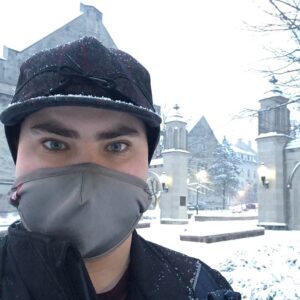
Ryan Edward Peterson, doctoral candidate and research fellow at the IU Museum of Archaeology and Anthropology. | Courtesy photo
Ryan Edward Peterson, doctoral candidate and research fellow at the IU Museum of Archaeology and Anthropology, has been interested in studying about the past from a young age. While he enjoyed history classes in middle and high school, he also watched history documentaries “for fun.” Such experiences inspired his interest in archaeology, his college major at Northern Michigan University, where he was appointed a McNair’s Scholar. The appointment led to a summer internship to work with National Park Service archaeologist Seth DePasqual at Isle Royale in Lake Superior, a place that was “eye-opening” for Peterson.
Peterson’s internship experience led to his Ph.D. specialization in archaeometallurgy at IU–Bloomington. He says, “As an archaeometallurgist, I study metalsmithing in the past. I believe that to understand how metalsmiths interact with metals today, we must first understand how people did in the past. One way that I do this is by recreating metal production processes used by people in the past.”
As a Great Lakes archaeologist, he studies the organization of the copper production system in the northern Lake Superior Basin. The system has been around for over 9,500 years, making it one of the world’s oldest metalworking traditions. He also studies how the region’s copper had been procured and transported through migration to be used for the creation of tools and ornaments.
While engaged in dissertation research, he realized that he needed to recreate the copper production process to deepen his understanding about it. The IU jewelry design and metalsmithing program gave him the workshop space for doing just that. He says, “I was able to interact with all the wonderful students and faculty of this program and exchange ideas on how to think about metalsmithing.” Such interactions, together with his specialization in archaeometallurgy, led to an invitation to participate in RJM as a speaker.
Peterson will speak more about his research interests at a symposium that will be held with the RJM exhibition’s opening reception. These interests include technology shifts in copper production with a focus on jewelry and ornamentation, and the environmental impact of mining on cultural heritage sites. He says, “Cultural heritage sites, like the environment, once destroyed, there is no going back.”
Responsible sourcing
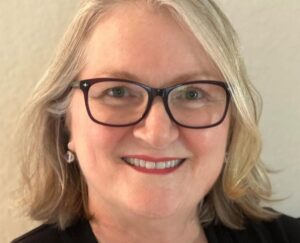
Barbara Wheat, executive director of Ethical Metalsmiths | Courtesy photo
According to Barbara Wheat, executive director for Ethical Metalsmiths, the organization’s mission statement is “Inspiring responsible jewelry practices through education, connection, and action,” while EM envisions “a jewelry industry where a beautiful product does not bear a human or environmental toll.”
For Wheat, the most rewarding aspect of service as EM’s executive director is “being part of the EM community.” She also enjoys working with people who “share common goals and values,” especially community members who are students or emerging jewelers. She says, “It is thrilling to see EM members learning to make jewelry and, at the same time, learning practices that lessen negative environmental and human impacts.”
For Wheat, EM’s greatest success has been raising environmental awareness about mining for jewelry production. She says, “When EM was founded in 2004, not many people were willing to engage in discussions about responsible sourcing and other topics related to jewelry making. I believe the organization has helped move these conversations forward by making these topics more mainstream.”
Although Wheat has been with EM for 18 months, her work with nonprofits in the gem and jewelry industry for over 25 years enables her to see that more work needs to be done toward enabling “responsible sourcing.” Even so, as head of EM, she finds rewarding the chance to enable members to achieve their goals. She says of her role, “It’s not just a job, it’s more of a life experience.”
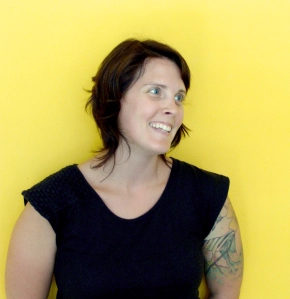
Lucy Louise Derickson, education director at Ethical Metalsmiths | Courtesy photo
Lucy Louise Derickson, education director at Ethical Metalsmiths, has always been involved in the arts. When she was an undergraduate student at the University of Wisconsin–Milwaukee, she was immediately drawn to metalsmithing, “the processes, tools, and variety of ways metal can be controlled and transformed.”
At the time, she discovered EM’s RJM project through RJM’s co-founder and director, Susie Ganch, who had given a lecture at UWM. She also learned about the environmental damage caused by mining and the human rights violations that often come with the process of extracting metal from the earth.
Ganch’s lecture inspired Derickson to study with her at Virginia Commonwealth University. There, she participated in an RJM installment, RJM IX: Richmond, 2014. “My plan has always been to stay in academia,” she says. Now she is an assistant professor at Montgomery College in Rockville, Maryland, and coordinator of the college’s jewelry and metalsmithing/crafts area. As full-time faculty and area coordinator, she hopes to promote “wise studio practices” while decision making for her program.
According to Derickson, planning for RJM Bloomington started when Jacquard and Caldwell reached out to Ganch and Kathleen Kennedy, EM’s RJM team, saying they were interested in hosting an RJM project at IU–Bloomington. Derickson says RJM involves volunteer miners, smelters, refiners, jewelers, and metalsmiths who collaborate to create “a new and transparent supply chain.” She explains: “Each RJM installment is centered around a learning community, whether that be a single school or a number of educational institutions within a specified region working together.”
For RJM Bloomington, that learning community comprises IU and five other Midwest universities. Students from this consortium, together with jewelers from Chicago’s Gallery 2052 and faculty at the IU Eskenazi School of Art, Architecture + Design, will transform RJM donations into responsibly sourced jewelry.
These recreated pieces will be exhibited at the Grunwald Gallery of Art from January 12 through March 2, 2024. (Check the Grunwald Gallery for updates.) The exhibition’s opening reception will be held 5–8 p.m. on January 19, together with a symposium where presenters will talk about the mining process or the history of jewelry. Student speakers will also talk about their ongoing work and their experience with RJM Bloomington.
While the RJM exhibition is ongoing, pieces will be available for purchase. Proceeds from sales will be donated to Ethical Metalsmiths.
The Legacy of Alma Eikerman
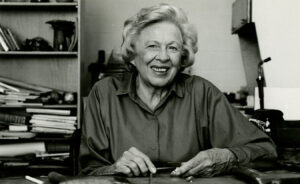
Alma Eikerman’s legacy has inspired generations of artists and arts educators. She was an innovative metalsmith, jewelry designer, and professor at the IU School of Fine Arts from 1947 to 1978. | Photo courtesy of Indiana University Archives
The metals program at Indiana University has a long and impressive lineage. It was started in the 1940s by Prof. Alma Eikerman, a pioneer in the metalsmithing field, a jewelry designer, and a beloved professor at the IU School of Fine Arts from 1947 to 1978. Eikerman’s legacy has inspired generations of artists and students who went on to teach across the U.S. and abroad.
“I tell my students that you are not far from the legacy of Alma and the impact she has had on the field and who she educated,” says Nicole Jacquard, area head of metalsmithing and jewelry design at the IU Eskenazi School of Art, Architecture + Design. For example, Eikerman taught Bloomington High School North teacher Fred Brandenburger, “who was also my high school teacher,” Jacquard says.
Read more in “Alma Eikerman’s Legacy Still Inspires Metalsmiths, Jewelry Designers,” by Ann Georgescu.

